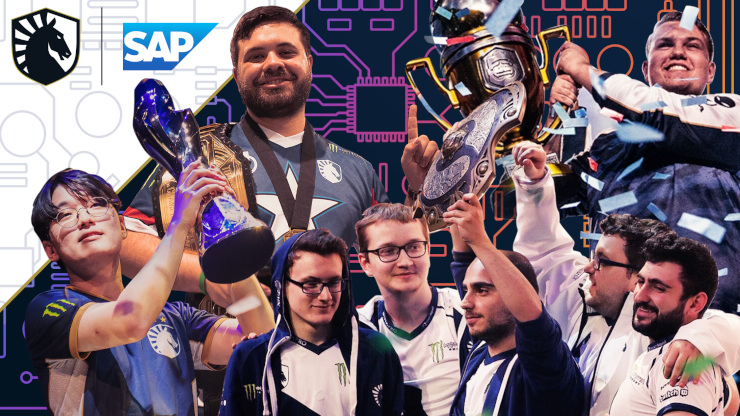For years, most traditional sponsorship deals have been fairly simple. Brands have tended to pay organisations for promotion, with team jerseys being the hottest spot for logo placement, usually taken by the biggest fish. Compared to advertisements, there’s barely any difference.
In the esports industry, sponsorship is the major source of revenue for most businesses, yet it’s becoming less and less common to see a mere logo-placement kind of deal. Instead, all sorts of two-way collaborations flood the market.
Take the recent Team Liquid partnership with German software corporation SAP. Using its business technology platform with predictive and machine learning functionalities, the company reportedly helps Team Liquid’s Dota 2 team improve its match preparation routines, gain new strategic insights and ultimately elevate its gameplay. All of this in return for space to showcase SAP technology.

RELATED: Opinion: In esports, what determines brand prestige is success — not content
Another example is Team Vitality’s partnership with analytics firm Newzoo. The companies exchange data and insights with the goal of creating an ‘enhanced view’ of the esports market. This way, Team Vitality is able to understand its audience better and make more sound decisions, while Newzoo has a first-hand data stream for its market analyses.
It seems as if partnerships and collaborations are slowly replacing traditional sponsorship as we know it. Dan Houl, Head of Esports, Gaming, Digital Payments at a global payment technology company Nuvei explained why logo placement strategy is no longer favoured among brands and sponsors.
“In business deals like this, you pay thousands, even millions of dollars for visibility and promotion towards the audience. This might work for B2C brands, but for many B2B companies like Nuvei, this makes no sense,” said Houl. “Having our logo featured on the jersey of a famous team is not going to make us any money.”
What’s making such deals potentially even less attractive to sponsors, especially among B2B companies, is the uncertainty of the investment. “You, as a company, provide money upfront, often without knowing what it will be used for and if you get anything from it,” said Houl.
Sure, there’s the prestige that comes with the connection to a prominent team, but the return of investment may stay unknown. To address this, Houl suggests shifting from doing business the way it was being done for decades in traditional sports.
“We need to change our way of thinking about investing,” he said. “Companies today are so well developed that if everyone was doing partnerships and referral programmes rather than advertising, we would have a much better ecosystem.”

According to Houl, it all starts with understanding what each side is trying to achieve and ensuring that their requirements are compatible. The deal should be transparent and beneficial for both sides.
To give a better perspective on how such negotiations might look, Houl gave an example:
“If a potential partner asks for money first, I ask if they have any partners that don’t have our technology and see if we can help them. If we sign with them, then we can share our revenue.”
“Is it not more fair to do this?” asked Houl. “Is it not a win-win situation? The answer is yes because we both made the effort, and now we share the reward. So it all comes down to providing value for both sides.”
Connection and communication
Apart from different investments, Houl sees an opportunity in the way of communicating with audiences. In this case, esports should learn from traditional sports.
“Esports is all about connection to community, yet we don’t use its potential fully,” he said. “In traditional sports, athletes are now a part of marketing strategy and communication with the audience.”
Now with 300 million followers, footballer Cristiano Ronaldo is the most followed individual on Instagram. His personal branding is arguably the most successful athlete marketing campaign. Lionel Messi and Neymar are just a few tens of millions behind.

“Professional players are strong personalities, often with great fanbases behind them,” Houl said. “The communication between them comes more naturally.
“I’m really amazed how footballers connect with their audiences. It’s not only influencer marketing but rather a real connection with their fans, even outside of the sport as their mutual interest. Aguero, Kevin De Bruyne, Neymar — all these guys also connect with their fans over stream, playing video games.”
According to Houl, it is this authentic connection that makes the investment potentially more lucrative than sponsoring an organisation. Looking at the esports space, however, a great part of professional players are focused predominantly on the performance side, and the more profound connection with fans is often lacking.
RELATED: Nuvei on effective monetisation in esports and the appeal of cryptocurrency
Organisations compensate for this by signing streamers and influencers, and so far, this strategy appears to be working well for them. However, there’s an unexplored potential that lies in the deeper personal connection of players with their communities. “When it comes to communication, I think we should get inspired in how some traditional sports athletes speak to their audience and do more of that in esports,” concluded Houl.
Supported by Nuvei

